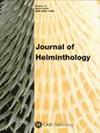希腊特里卡拉地区绵羊和山羊养殖户控制线虫寄生虫的做法
IF 1.3
3区 生物学
Q4 PARASITOLOGY
引用次数: 0
摘要
通过走访农场和采访农民,以问卷调查的形式收集了希腊中部特里卡拉地区绵羊和山羊养殖户的虫害防治方法的相关信息。共收集了居住在 23 个农村社区的 57 位农民的调查问卷。89% 的养殖户使用了抗寄生虫药物。羔羊、儿童和山羊平均每年治疗一次,而绵羊每年治疗一次或两次。只有 2% 的养殖户报告说,在迁移到新牧场时使用过驱虫药。最常用的广谱驱虫药是苯并咪唑类和丙苯并咪唑类。59%的养殖户在三年或三年以上的时间里使用同一类抗虫药,34%的养殖户在同一年使用两种或两种以上的抗虫药。几乎所有养殖户都报告说,他们通过目测平均体重(96%)来估算活体重量,从而计算抗虫药剂量。片剂和栓剂是 96% 的农民最喜欢使用的抗虫药剂型。58% 的养殖户根据兽医的建议选择驱虫药,39% 的养殖户根据药物成本选择驱虫药。给牲畜驱虫最常见的情况是在出栏时(86%)和产后(31%)。只有 6% 的养殖户表示在将新牲畜引入农场前进行了驱虫。养殖户更愿意从兽医(63%)和其他养殖户(37%)处了解有关使用驱虫药和驱虫策略的信息。本文章由计算机程序翻译,如有差异,请以英文原文为准。
Nematode parasite control practices of sheep and goat farmers in the region of Trikala, Greece
Information concerning worm control practices of sheep and goat farmers in the region of Trikala (central Greece) was collected through a questionnaire survey by visiting farms and interviewing farmers. Questionnaires from 57 farmers residing in 23 rural communities were collected. Anthelmintics were used by 89% of the farmers. On average, lambs, kids and goats were treated once annually, while sheep were treated either once or twice annually. Only 2% of farmers reported treatment of animals with anthelmintics when moving to new pastures. The most common broad-spectrum anthelmintics used were those belonging to the benzimidazoles and probenzimidazoles. Fifty nine percent of the farmers used the same anthelmintic group for 3 or more years and 34% used two or more anthelmintic groups in the same year. Almost all farmers reported estimating live weights for calculating anthelmintic doses through visual perception on the basis of an average weight (96%). Tablets and boluses were the most preferred anthelmintic formulation used by 96% of farmers. The selection of an anthelmintic was based for 58% of farmers on recommendation by a veterinarian and for 39% of farmers on the cost of the drug. The most common occasions for deworming the animals were at turn out (86%) and after parturition (31%). Only 6% of farmers reported deworming new animals before introducing them onto the farm. Farmers preferred to seek information about the use of anthelmintics and worm control strategies from veterinarians (63%) and other farmers (37%).
求助全文
通过发布文献求助,成功后即可免费获取论文全文。
去求助
来源期刊

Journal of Helminthology
生物-动物学
CiteScore
2.80
自引率
12.50%
发文量
127
审稿时长
3 months
期刊介绍:
Journal of Helminthology publishes original papers and review articles on all aspects of pure and applied helminthology, particularly those helminth parasites of environmental health, medical or veterinary importance. Research papers on helminths in wildlife hosts, including plant and insect parasites, are also published along with taxonomic papers contributing to the systematics of a group. The journal will be of interest to academics and researchers involved in the fields of human and veterinary parasitology, public health, microbiology, ecology and biochemistry.
 求助内容:
求助内容: 应助结果提醒方式:
应助结果提醒方式:


